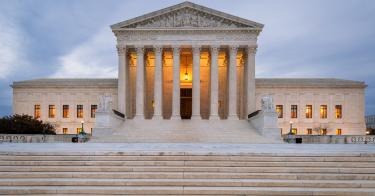It’s unusual to see news articles about disagreements between Supreme Court Justices, especially with phrases like “fed up,” “fighting words,” and “took the gloves off” in the headlines. It’s even more unusual when the dispute in question is between two Justices of the same ideological bent. And yet in recent weeks that’s what has occurred with Justices Amy Coney Barrett and Clarence Thomas.
This term, Barrett and Thomas have criticized each other’s use of history in two cases: Vidal v. Elster and United States v. Rahimi. In short, Barrett requires more proof of a historical practice, and Thomas requires a tighter historical analogy.
Elster and Rahimi show the two originalists’ different approaches. In Rahimi, the Court upheld a law that disarmed anyone subject to a certain kind of restraining order. Under its recent Bruen precedent, the Court asked whether that law—18 U.S.C. §922(g)—was analogous to historical restrictions on firearms.
The majority said yes, pointing to a historical tradition of disarming dangerous people. It focused on two types of historical laws: surety laws and affray laws. Surety laws gave officials the power to force potentially violent or abusive gun owners to post a bond. The gun owners would forfeit their bonds if they later committed any crimes. Affray laws took guns away from people who used them to intimidate others. Those two types of laws, the Court reasoned, were analogous to the law disarming people subject to protective domestic violence orders.
Barrett said the Court chose “just the right level of generality” for its analogy. Thomas didn’t dispute that there was a tradition of surety and affray laws, but he didn’t think they were analogous to §922(g). Although §922(g) criminalized possession of weapons by dangerous people, he said, surety laws let individuals keep their firearms if they posted bond. Surety and affray laws did establish a tradition, but not one that justified §922(g). The difference in Rahimi was about drawing analogies more than questioning history.
Although Barrett accepted a looser analogy than Thomas in Rahimi, she had a higher standard for historical clarity than he did in Elster. Elster was a First Amendment challenge to a trademark statute. The statute stopped Elster from registering another person’s name as part of his trademark. Thomas’s majority opinion upheld the statute because trademark law has traditionally restricted registering names as trademarks. That tradition, however, wasn’t clear enough for Barrett. She believed that the majority ignored “countervailing evidence” in the form of cases allowing names to be trademarked. As she put it, “the Court has not cleared the historical analogue bar it sets for itself.” Thomas thought those examples fit within the framework he’d outlined in his majority opinion, but that explanation didn’t satisfy Barrett. She wanted more proof.
Elster and Rahimi present a puzzle. In Elster, Barrett criticized Thomas for failing to consider enough analogies, and in Rahimi, Thomas criticized an opinion joined by Barrett for failing to present a sufficiently tight analogy. What explains this disagreement? Is Thomas or Barrett being inconsistent? Hypocritical? Results-oriented? No, the two Justices simply have different views about how historical analogies show us the Constitution’s meaning.
Historical analogies have two parts: the history and the analogy. Barrett demands more evidence of history, but Thomas requires a closer analogy.
Start with the history. One historical anecdote doesn’t constitute a historical practice. That fact raises lots of questions. How many historical examples amount to a practice? Can there be outliers? How many outliers before there’s no longer a tradition? Barrett tends to demand more examples, and tolerate fewer outliers, than Thomas does. Next, consider the analogy. How closely must a historical example match its modern counterpart? How similar do their goals have to be? What about the means they use to further those goals? Thomas demands more similarity than Barrett.
Thomas and Barrett’s disagreement in these cases is echoed elsewhere too. Three years ago, Thomas joined a concurrence in Fulton v. Philadelphia urging the Court to overrule a Free Exercise Clause precedent, partly because of history. Concurring, Barrett said, “I find the historical record more silent than supportive.” A year after that disagreement, Barrett wrote a concurrence in Samia v. United States calling some of Thomas’s historical analysis “beside the point.”
Although some of the disputes between Barrett and Thomas center on originalist theory, the ones outlined here mostly just concern the normal business of judging: using practice and precedent to reason by analogy and decide a case. As Thomas wrote in an opinion that Barrett did join, the “historical inquiry that courts must conduct will often involve reasoning by analogy—a commonplace task for any lawyer or judge.” Barrett and Thomas may disagree about how to draw analogies, but they agree on their importance.
Unsurprisingly, detailed historical and analogical reasoning rarely makes headlines. It’s not inherently political, it’s hard to condense into 280 characters, and it taxes readers’ attention spans. It is, however, the normal task of judging and a frequent source of good-faith disagreement. One of Barrett’s and Thomas’s strengths is that their legal disputes mostly surround methods and analogies, bringing those to the fore and ensuring that the “commonplace task” of judging persists in the marble palace at One First Street.
This piece originally appeared in the Federalist Society





